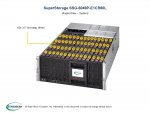Hi,
I’m in the planning stages of building a NAS for editing videos across a number of video editors. I’m planning on using a HGST 60 Bay disk shelf and using a PC box to control that using a SAS HBA. All computers will be connected to the server using 10Gbe through a switch. As for the hardware side, I’m pretty much all set. However, I’m trying to wrap my head around the way FreeNAS handles the HDDs (pools and shares). Since I’m not going to populate the entire 60 bays right off, I’m wondering if anyone can share their thoughts and ideas how to tackle this.
I’m starting with 12x 6TB (set 1), 6x 12TB (set 2) and 2x 256GB as a cache. My objective is to use RAIDZ2 per 12 HDD.
With the above, do I go with the following:
Option A:
1. Do I create everything in one pool?
2. Later on, if I add another 6x 12TB, would it be able to expand set 1 without making this new set as a separate RAIDZ2.
3. If I continue to expand the pool until I populate all 60 bays, will it always be based on the sets of HDD before?
Option B:
3. Do I create separate pools for each set and continue to create separate pools each time I have a new set of drives?
4. Does the cache work globally for separate pools?
Please share your insights since I’m at the beginning of buiiding this. The last thing I need is to have a 144TB and need to rethink my breakdown as I populate the bays in the disk shelf.
I’m in the planning stages of building a NAS for editing videos across a number of video editors. I’m planning on using a HGST 60 Bay disk shelf and using a PC box to control that using a SAS HBA. All computers will be connected to the server using 10Gbe through a switch. As for the hardware side, I’m pretty much all set. However, I’m trying to wrap my head around the way FreeNAS handles the HDDs (pools and shares). Since I’m not going to populate the entire 60 bays right off, I’m wondering if anyone can share their thoughts and ideas how to tackle this.
I’m starting with 12x 6TB (set 1), 6x 12TB (set 2) and 2x 256GB as a cache. My objective is to use RAIDZ2 per 12 HDD.
With the above, do I go with the following:
Option A:
1. Do I create everything in one pool?
2. Later on, if I add another 6x 12TB, would it be able to expand set 1 without making this new set as a separate RAIDZ2.
3. If I continue to expand the pool until I populate all 60 bays, will it always be based on the sets of HDD before?
Option B:
3. Do I create separate pools for each set and continue to create separate pools each time I have a new set of drives?
4. Does the cache work globally for separate pools?
Please share your insights since I’m at the beginning of buiiding this. The last thing I need is to have a 144TB and need to rethink my breakdown as I populate the bays in the disk shelf.
Last edited:

